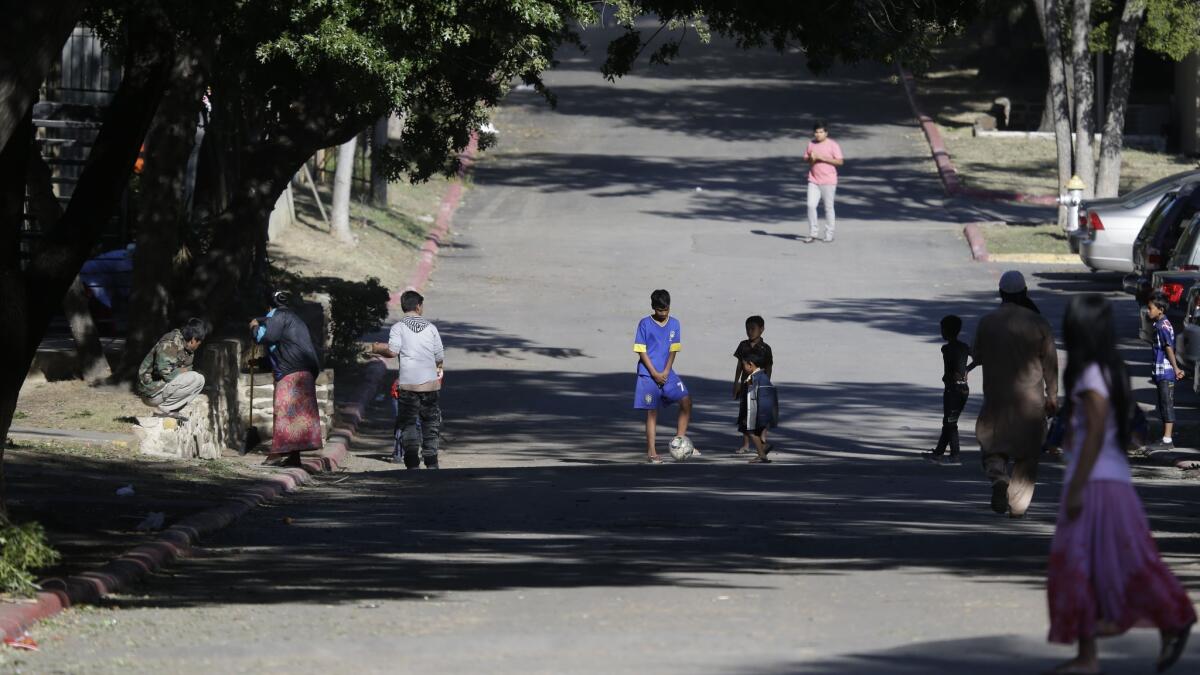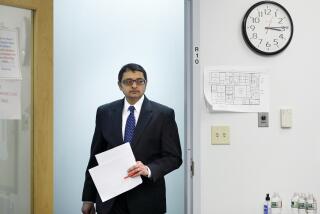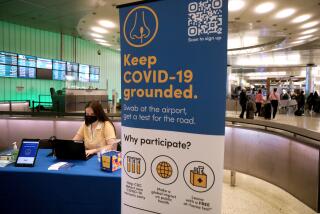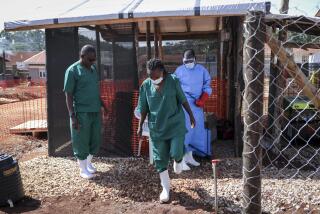Disease detectives on the hunt to confine Ebola virus

- Share via
Reporting from Dallas — A team of disease detectives, quietly working behind the scenes, has fanned out across Dallas amid the swirl of activity around a Liberian man who arrived here infected with the Ebola virus.
For public health officials, the team is the key to containing the virus. It includes experts from the federal Centers for Disease Control and Prevention, some fresh from working the outbreak in West Africa, as well as a cadre of local health workers.
They are part of a key process in combating infectious diseases known as contact tracing.
The exercise can be surprisingly low-tech — “shoe leather epidemiology,” practitioners sometimes call it — involving a lot of door knocking, talking and careful listening.
It’s a tried-and-true method of curtailing illness and saving lives, experts say. Executed early and well, the approach can cut off an outbreak — even a horrific and deadly one like Ebola — before it explodes out of control.
“Contact tracing is your No. 1 way of controlling the epidemic,” said Dr. Craig Smith, a spokesperson for the Infectious Diseases Society of America. “If we can’t stop the clinical symptoms, we have to stop the transmission.”
Contact tracing is one of a number of boots-on-the-ground measures in modern epidemiology’s toolbox.
The field of epidemiology was born in 1854, said Dr. Melinda Moore, a senior scientist at the RAND Corp. in Arlington, Va.
Dr. John Snow was trying to figure out why Londoners were falling ill with cholera. At the time, scientists did not know that diseases were caused by germs and did not understand why illnesses spread.
Snow went door to door, tracking down sufferers and their families, questioning them in detail. He noticed that many deaths seemed to occur in people who drank water from a single pump on Broad Street.
He urged city officials to remove the handle from the pump, making it impossible for drinkers to access the water. They did — and the epidemic subsided.
The general principles that Snow pioneered — tracking down people involved in an outbreak, methodically reconstructing the creep of disease and acting to interrupt transmission — apply across the board. The specifics can vary by disease, said Smith of the Infectious Diseases Society of America.
Public health teams tweak their strategies depending on how a disease spreads and how long it incubates silently in the body before symptoms erupt.
Catching Ebola requires contact with an infected bodily fluid, such as blood, vomit or diarrhea. The virus represents a nightmare foe for medicine because it is so consistently deadly once it strikes.
But Ebola’s epidemiology can make it a “unique and convenient” disease to target through contact tracing, Smith said, because the contagious phase doesn’t begin until a patient is already sick.
This means trackers on the ground in Dallas wouldn’t have to seek out contacts who might have encountered Thomas Eric Duncan before Sept. 24, when he first developed symptoms — including dozens who shared the flights he took from Monrovia, Liberia, to the U.S.
But the Dallas team would relentlessly pursue anyone who might have had significant contact with the patient between Sept. 24 and Sept. 28, when Duncan was finally admitted to the hospital, Smith added.
“They’re going to say, ‘24 hours a day, minute by minute, where was he, what were his activities, who was he in contact with?’” Smith said.
“They probe and probe,” added Moore, who worked as a disease investigator over the course of a 20-year stint at the CDC, investigating a variety of outbreaks in the U.S. and abroad.
In an Ebola investigation, trackers follow contacts for 21 days, which is the maximum time it takes for the virus to incubate. If a contact doesn’t display symptoms within that period of time, he or she is not at risk of developing Ebola.
If the contact does fall ill, he or she is treated immediately and is placed in isolation — and another 21-day round of contact investigation and follow-up begins.
In Dallas as of Friday, teams were focused only on Duncan’s contacts, said CDC spokesman Dave Daigle.
During a news conference the previous day, Daigle, who in August returned from another Ebola contact tracing stint in Nigeria, told reporters that disease detectives had “cast a very wide net” in Texas in an effort to make sure no one was missed.
On Friday, federal and local officials said that they were monitoring 50 people on a daily basis, 10 of whom were considered to be at high risk.
Ten county health department epidemiologists are working in conjunction with the CDC team to handle follow-ups, said Erikka Neroes, a spokeswoman for Dallas County Health and Human Services.
The workers, fresh from tracking cases of enterovirus D-68, are often working past midnight, she said.
Initial interviews of contacts are conducted in person by teams of two.
Follow-up, which involves recording contact temperatures and asking a series of questions about symptoms, generally takes place over the phone.
Tracers are doing face-to-face follow-ups with the family that hosted Duncan, because they were in close proximity while he was symptomatic, Neroes said.
Typically, local health teams that handle contact tracking aren’t stocked with scientists, doctors or nurses; rather, workers are technicians, who follow a script or a checklist as they review key details with patients, Smith said.
But the simplicity of the process belies the care required to do the job well, public health workers said.
Tracing can be difficult if a patient is not honest or is not familiar with a disease. CDC director Dr. Thomas Frieden has alluded to this when discussing Duncan, who may not have told airport workers in Liberia that he had been in close contact with an Ebola victim.
Missed nuances in communication can complicate information-gathering as well.
“You have to come here and talk Georgia to me,” said Smith, who works as an infectious disease specialist at University Hospital in Augusta, Ga. “You have to be sensitive to people’s culture.”
In Nigeria, Daigle said during the Thursday news conference, some contacts were hesitant when approached by tracers.
Many had heard rumors about Ebola. Some believed saltwater might be an effective cure.
Contact tracers learned to be persistent, Daigle said.
Ultimately, the outbreak was contained.
Times staff writers Molly Hennessy-Fiske in Dallas and Tina Susman in New York contributed to this report. Brown reported from Los Angeles.
For more news on Ebola and public health follow @LATerynbrown on Twitter.
More to Read
Sign up for Essential California
The most important California stories and recommendations in your inbox every morning.
You may occasionally receive promotional content from the Los Angeles Times.











